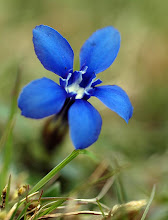This cross section of the stem of a soybean seedling shows the early stages in a developmental process that will produce a stem capable of supporting the mature plant. I stained the section with two fluorescent dyes - calcofluor, which binds to cellulose cell walls and fluorescences blue in ultraviolet light and auramine O, which binds to lignin and fluorescences yellow. It's the lignin laid down in cell walls that gives the stem the strength it will need to support the leaves and flower.
Working from the bottom left-hand corner towards top right, the core of the stem is filled with blue, thin-walled pith cells, which are simply packing tissue. Some of these have become slightly lignified and are fluorescing yellow and some, that are arranged in vertical rows of between two and five cells have distinctly thicker walls - these are xylem vessels, which are dead cells that form tubes that conduct water up the plant from the roots.
Above those lies a broad band of blue-fluorescing thin-walled cells that are very small and arranged like piles of bricks. This is the cambium - the plant's stem cells that divide continuously to produce new xylem on the inside and new phloem elements on their outer surface. The small, bright blue-fluorescing cells on the outside of the cambium are the phloem sieve tubes and associated companion cells, which conduct sugars produced by photosynthesis in the leaves to other parts of the plant.
The sinuous layer of yellow-fluorescing cells above the phloem are becoming lignified and these will contribute major structural rigidity to the stem as it grows, forming a continuous cylinder inside the stem. Outside of these lies the stem cortex, with blue cells becoming smaller in the layers just below the epidermis - and then the outer epidermis of the stem is covered in the yellow-fluorescing cuticle, which restricts water loss and defends that plant against pathogens.
At the stage when this section was taken the stem was about 3mm. in diameter and about 10 centimetres tall.















Beautiful and very informative. The photos in my "botany for gardeners" book are *ugly* compared to this. :-)
ReplyDeleteHi Alan, I'm a great fan of these fluorescent dyes - it's like turn a light on inside the cells.
ReplyDeleteYour microscopic pictures are amazing...I am an artist and am so inspired by the beauty at this level of seeing! You should sell them as art prints and frame them :)
ReplyDeleteFluorescence is great isn't it Alan - like turning a light on inside the cells!
ReplyDeleteThanks Colleen - and that's a good idea about the prints - I might give it a go...
ReplyDelete